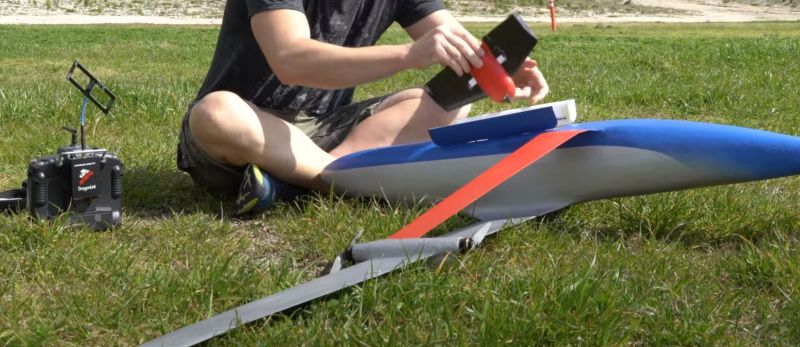Following NASA’s recent results with truss-braced wing airplanes and the benefits this could bring to full-sized airplanes, [Think Flight] figured that if it helps with those airplanes, perhaps it may also be a boon for model airplanes. With the recent construction of a carrier airplane for smaller drones, he decided to give the concept a whirl to see whether it would make a difference compared to a regular wing design. This carrier airplane features a payload bay that can be opened in flight to release the drones stored inside it, making any potential increased payload capacity and improvements to the flight characteristics very welcome.
The truss-braced wing design has been studied by NASA and Boeing, with the design offering a high aspect ratio, not unlike the wings of a glider. The obvious disadvantage of those long, narrow wings of a glider is that they are also long and fragile, which are not desirable properties on a commercial jetliner. By adding the truss bracing, the wing design can be optimized for high aspect ratio, while the fragility is compensated for by the trusses. For a commercial jetliner, this could mean significant less fuel usage.
As [Think Flight] found, however, the typical issues with scaling wings up and down were apparent here too, with Reynolds number explaining the ‘why’, involving the chord length of the aerofoil, which is obviously different between a full-sized jetliner and a model you can hold in your hand. Effectively this means that on a model scale, the effect of higher aspect ratio isn’t as pronounced as it is with jetliners, even if the trusses may offer some benefit in structural rigidity.
















Is that what inland California looks like after some serious rain? Wow…
Very impressive work and video!
I have an idea for a variation on this truss wing design (inverted, with outriggers, distributed load, some aerodynamic and structural benefits). Let me know if you’re interested. I can send a picture.
Nevermind, I’m blind; the Wikipedia page was linked
I’m really missing something here. Wing trusses (if that is what they are called) have been around almost as long as aircraft, are used in many civil aircraft like the humble Cessna 152 (“the Volkswagen of the sky) and bigger cousins in the series, plus tons of other aircraft. For, what I assume are similar reasons, although I’m not an aviation engineer or anything. I don’t get why this is NASA-research worthy.
There aren’t currently any truss braced wing designs flying at the Mach ~0.80+ speeds that jetliners cruise at. Building a flying test aircraft is the aim of the NASA research.
I fly sailplanes and the design requirements for subsonic jet airliners and sailplanes are so different I’m not surprised they have massively different wing plans. Sailplanes circle at like 2kt above stall speed and (with notable exceptions) fly at L/D max, maybe 60-80kt, something a high aspect wing is very good for. Airliners or other powered aircraft have no such design requirements so I’m struggling to see why a wingform that is ideal for massively different requirements is even thought to maybe be “better.” Even the description in the article says hoping for higher efficiency or something. But the linked Wikipedia articles don’t help at all.
I was also confused by this, as I read a quote a while back by a Lockheed engineer who said he’d sell his grandmother for a point, a 0.1% reduction in drag, and adding struts is going to add drag unless it results in a big decrease in wing thickness and resultant overall lowering of drag.
But I ran across the NASA research being done, and sure enough, it’s a sailplane-like wingform. Look up boeing truss-based wing. There’s a wikipedia article on it (but if I include links, historically it takes like a whole day for hackaday to approve the comment.) They’re designing aircraft with high L/D, high-aspect-ratio wings that operate in the low transonic range, with the design concept of jet engines for takeoff and electric for cruise and landing, but targeting a cruise of M0.75. I think that’s pretty cool.
Speaking to the differences in design requirements between the aircraft. I am continually amazed air frames like the 737 and larger get off the ground. I went down a rabbit hole one day looking into wing design and what cargo jet aircraft have to do to their wings just to take off and land is mind boggling.
Slats, slots, cuffs, ailerons… all of which move and come in a wide variety of configurations and types. Then there are all the little aerodynamic band-aides that get tacked on to assist the moving parts like vortex generators and vortilons. Moving parts are HEAVY and more complex the movements mean more non-working weight.
Its a wonder the damn things ever get airborne.
The reynolds number of a wing is (bunch of stuff) * Chord * Velocity.
A model is less than useful in this case. You just can’t increase 0.8 mach by the chord ratio to get into a similar range for testing.
Perhaps if you could fly it at high pressure or use another working fluid for study.
Higher aspect ratios are always better aerodynamically (subsonic). Less drag. But structural issues.
Cool video and beautiful flights. I’m a bit confused on one thing, though. What is the difference between a “strut brace” vs a “truss brace” and how does that difference impact the design?
He mentions it very briefly – the difference is a truss brace wing has the little jury brace connecting the strut to the wing to help stabilize it – whereas the strut brace wing is only a strut with no little jury braces.
Confusingly, the images of the Boeing aircraft model in the wind tunnel don’t seem to include the jury, but the renderings of the full size aircraft do include it.
I always enjoy his videos